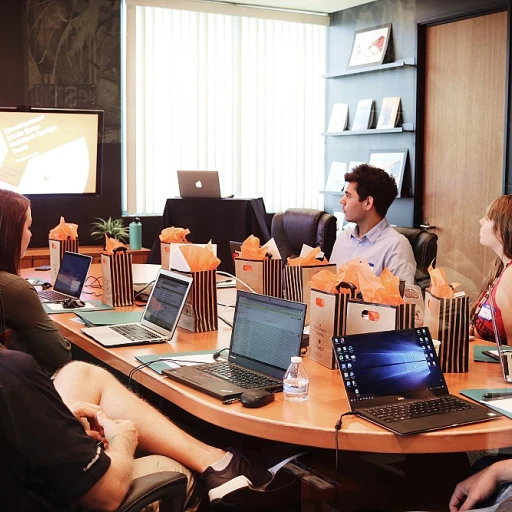
Understanding the People, Process, and Technology Framework
Grasping the Essence of the Framework
In the evolving landscape of human resources, innovation is often driven by the integration of three essential components: people, process, and technology. This trio, commonly referred to as the PPT framework, forms the backbone of organizational change and improvement. The framework is designed to optimize workforce management by developing strategies that leverage these three elements harmoniously. By doing so, organizations can streamline decision making and enhance customer service by focusing on employee capabilities aligned with business objectives.The Key Components
- People: In this context, 'people' implies not just employees, but a broader involvement that includes customers, stakeholders, and management teams. Engaging them in continuous training and development processes ensures that they are equipped to adapt to the rapid changes in the business world.
- Process: Efficient management of systematic processes is crucial for achieving consistent output. Emphasizing best practices in processes enables an organization to respond agilely to market demands and internal challenges, ensuring that the workforce operates at peak efficiency.
- Technology: Digital transformation is reshaping the business landscape. Employing the right technology tools can propel innovation within HR systems, driving an efficient collection and utilization of data to foster informed decision making and improve overall business strategies.
The Role of People in HR Innovation
Empowering the Human Element in HR Innovation
In the realm of human resources, the role of people is undeniably central to driving innovation. The people, process, and technology framework emphasizes the importance of human capital as a key component in transforming HR practices. Organizations must recognize that employees are not just resources but pivotal agents of change and innovation.
Fostering a Culture of Innovation
To truly harness the potential of people in HR innovation, businesses need to cultivate a culture that encourages creativity and adaptability. This involves empowering employees through continuous training and development programs, ensuring they have the skills necessary to navigate the evolving landscape of HR technology and processes. By investing in their workforce, organizations can foster an environment where innovative ideas flourish.
Enhancing Decision-Making and Collaboration
Effective decision-making is crucial in leveraging the people component of the framework. Encouraging collaboration across teams and departments can lead to more informed and strategic decisions. By integrating diverse perspectives, organizations can enhance their problem-solving capabilities and drive meaningful change. This collaborative approach not only improves customer service but also strengthens the overall business strategy.
Aligning People with Technology and Processes
The synergy between people, technology, and processes is vital for successful HR innovation. Employees must be equipped with the right tools and knowledge to effectively utilize technology in their daily tasks. This alignment ensures that the workforce is not only efficient but also adaptable to new technological advancements, ultimately leading to a more agile and responsive organization.
Building a Resilient Workforce
Incorporating the human element into the framework requires a focus on resilience and adaptability. Organizations should prioritize initiatives that support employee well-being and work-life balance, as these factors significantly impact productivity and innovation. By nurturing a resilient workforce, businesses can better navigate the challenges of digital transformation and remain competitive in a rapidly changing market.
Streamlining Processes for Effective HR Management
Optimizing Workflow for HR Efficiency
Streamlining processes is essential for enhancing the efficiency and effectiveness of HR management. The People, Process, and Technology framework provides a structured approach to refining the methods through which HR departments operate, ensuring that the interplay between these three components leads to optimum results.
A critical first step in this journey is understanding the current state of organizational processes and identifying areas for improvement. By engaging the team and involving various stakeholders, such as employees and managers, HR leaders can collect valuable data and insights that guide decision making. These insights help prioritize the processes most in need of optimization.
The use of efficient tools and techniques is indispensable for successful process transformation. Automation, for instance, can replace repetitive tasks, freeing up HR personnel to focus on strategic initiatives that add value to the organization. Furthermore, leveraging technology frameworks that incorporate knowledge management and project management capabilities ensures that HR functions are aligned with broader business objectives.
Implementing refined processes also involves change management strategies to ensure that employees are well-equipped to adapt. Providing training and resources helps them navigate changes seamlessly, ultimately leading to improved performance and customer service. The emphasis is on creating a harmonious balance between people, processes, and technology to foster a dynamic and responsive workplace environment.
In summary, a methodical approach to streamlining HR processes can drive significant change in an organization’s workflow. By integrating people, processes, and technology, the golden triangle of HR innovation can be effectively leveraged for sustainable growth and enhanced employee satisfaction.
Leveraging Technology for HR Transformation
The Strategic Impact of Technology in HR
Technology plays a pivotal role in transforming human resources, offering seamless integration across the people, process, and technology framework. By leveraging cutting-edge tools, organizations can enhance their decision-making capacities, streamline operations, and improve the overall employee experience. HR technology solutions like data analytics, artificial intelligence (AI), and cloud-based platforms are reshaping the workforce management landscape. These technologies provide valuable insights and enable organizations to harness data for more informed decision making. As a result, HR teams can proactively address potential challenges and optimize processes.Efficiency through Process Technology Integration
The integration of technology within HR processes is vital in achieving operational efficiency. By automating routine tasks, HR professionals are freed up to focus on strategic initiatives that foster employee engagement and development. Automation tools, such as applicant tracking systems and employee self-service portals, are transforming the way businesses manage their HR functions. Additionally, technology facilitates change management by providing employees with access to crucial training and development resources. E-learning platforms and virtual workshops empower employees to upskill and stay competitive in an evolving job market.Enhancing Customer Service and Workplace Environment
Incorporating technology into HR practices not only benefits the internal workforce but also enhances customer service. A knowledgeable and well-trained team is better equipped to address customer needs, ultimately strengthening customer relationships and brand loyalty. Moreover, digital transformation in HR supports a collaborative and transparent workplace environment. By utilizing communication tools and platforms, organizations can foster a sense of belonging and connectivity among employees, reinforcing a positive organizational culture. As HR continues to evolve, technology's role becomes increasingly significant. By strategically integrating technology within the people, process, and technology framework, organizations can drive innovation and achieve sustainable business success.Integrating the Framework for Maximum Impact
Achieving Synergy Across the Golden Triangle
Integrating the People, Process, and Technology framework within human resources (HR) unveils significant opportunities for innovation. However, to maximize its impact, organizations must effectively harmonize the three components for synergetic outcomes. The alignment of people, process, and technology—often referred to as the golden triangle—is crucial for successful HR transformation. Firstly, establishing a cohesive approach that brings together the workforce, processes, and digital tools is essential. This involves educating employees about the interplay of these elements within HR, fostering a shared understanding across the team. Regular training and knowledge management sessions can enhance employees’ decision making and change management capabilities, ensuring they are equipped to embrace new tools and methodologies. Secondly, organizations need to employ data-driven strategies to refine their HR processes. By analyzing employee data and customer service interactions, businesses can uncover insights that inform process optimization and workforce management. This empowers informed decisions, aligning HR strategies with business goals. A seamless integration also demands a robust change management approach. As organizations transition to a technology framework, clear communication and feedback loops are vital to address employee concerns and resistance. Change champions within teams can advocate for technological adoption and facilitate the transition. Lastly, maintaining a flexible approach to project management will allow HR departments to adapt to evolving technological trends and changing work dynamics. Engaging diverse teams in the process provides varied perspectives, enhancing the overall framework implementation. By strategically incorporating the three elements within HR practices, organizations can navigate the complexities of digital transformation, ultimately driving innovation and enhancing business outcomes.Overcoming Challenges in Implementing the Framework
Addressing Common Barriers
Implementing the People, Process, and Technology (PPT) framework in human resources can be transformative, yet it comes with its own set of challenges. Organizations often face resistance to change, especially when it involves altering established processes or adopting new technology. Employees may feel overwhelmed by the shift, and without proper change management strategies, the transition can falter.
Ensuring Employee Buy-In
One of the most significant hurdles is gaining employee buy-in. People are at the heart of any successful HR innovation, and their support is crucial. Engaging employees early in the decision-making process can help mitigate resistance. Providing comprehensive training and clear communication about the benefits of the new framework can also foster a more receptive attitude.
Streamlining Processes for Adoption
Streamlining processes is essential for effective implementation. Organizations need to evaluate existing workflows and identify areas where the new framework can enhance efficiency. This might involve rethinking customer service protocols or workforce management strategies to better align with the technology framework.
Leveraging Technology Effectively
Technology is a powerful tool in the PPT framework, but it must be leveraged effectively. Organizations should invest in tools that support their specific needs and ensure that employees are well-trained in using them. Data-driven decision-making can be enhanced through technology, but only if the data is accurate and accessible.
Integrating the Framework Seamlessly
Integration of the PPT framework requires a holistic approach. The three elements—people, processes, and technology—must work in harmony. This integration can be challenging, but by focusing on the golden triangle of project management, organizations can achieve a seamless transition. Best practices in knowledge management and digital transformation can guide this process.
Continuous Improvement and Feedback
Finally, continuous improvement is key. Organizations should establish feedback loops to gather insights from employees and customers. This feedback can inform ongoing adjustments to the framework, ensuring it remains effective and relevant. By fostering a culture of continuous improvement, organizations can overcome challenges and maximize the impact of their HR innovations.












